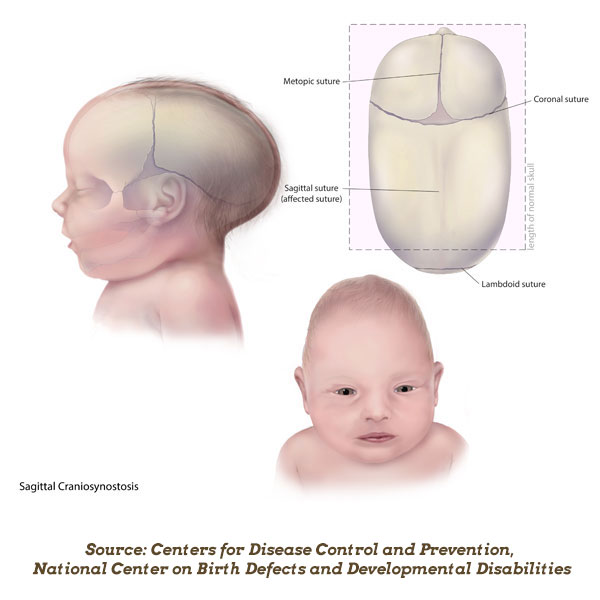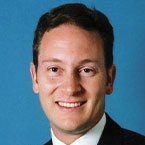Is It Normal for My Baby to Have Two Bulges on the Side of Her Head
By Peter J. Taub, MD, FAAP, FACS
It is not unusual for a baby's head to await a lilliputian lopsided. Because the individual bones of a newborn's skull aren't yet fused together, pressure from resting in the same position can cause an baby's head to be misshapen. This may include a flattened area.
While an asymmetrical head shape is a common cause of concern for new parents, a baby'southward head typically rounds out after birth. Flat spots may also meliorate, especially with position changes and extra tum time during play. If the deformation is moderate or astringent and not responding to position changes, a helmet may help.
Less commonly, an uneven head shape happens when the bones of the skull fuse together also before long. This rare condition, chosen craniosynostosis, may require surgery both to right the caput shape abnormality and in some cases to give the babe's brain room information technology needs to grow. It is estimated that nigh 1 in every 2,000 U.S. babies is born with craniosynostosis.
Infant's head: a brainy blueprint
The soft, flexible spaces between a baby's half dozen separate bones of the head, called "sutures," do more help the head squeeze through the birth canal. They also allow the skull to aggrandize rapidly during the starting time year of life, when the babe's brain more than doubles in size.
With craniosynostosis, 2 or more basic fuse together before a baby's brain growth is completed—sometimes even earlier nascency. Depending on which of the sutures close early, and where they are located, the shape of the skull, encephalon and face up can become distorted.
How is craniosynostosis diagnosed?
To aid determine what's causing a infant's uneven head shape, pediatricians will talk with parents to piece together a developmental and family unit history. They will as well comport careful examinations, looking at the baby'due south caput and confront from several dissimilar angles equally they search for raised or flattened areas and noting any asymmetry. This may be easier when the baby's hair is moisture.
These observations and information volition help differentiate positional plagiocephaly (acquired by simple pressure in one area) from craniosynostosis (caused by bony fusion).
One sign a infant's uneven head shape was caused by position alone is the classic parallelogram shape. Ane side of the caput may appear to be pushed forward, with the back of the caput being flattened, the ear moved slightly frontwards, and the forehead pushed slightly forward on the same side compared with the opposite side.
Your doctor may gently place a finger in each ear and note the position of their fingers relative to each other as observed from higher up the baby'south caput. In the example of positional plagiocephaly, the two fingers will not line up opposite each other. Plagiocephaly is more common on the right side, and also shows upwards more often in male infants.
Types of craniosynostosis
Skull bone sutures that fused too soon may be felt as ridges that run along diverse parts of the babe's caput. The baby's particular head shape will likewise point to the specific suture involved. Some of the more ordinarily seen types of head shapes, with the involved sutures, include:
-
 Scaphocephaly: A long, narrow caput is common with midline "sagittal" synostosis, when the suture extending from front end to back over the top of the head fuses too soon. Sagittal synostosis is the well-nigh common form of craniosynostosis, accounting for about 40% to 45% of cases.
Scaphocephaly: A long, narrow caput is common with midline "sagittal" synostosis, when the suture extending from front end to back over the top of the head fuses too soon. Sagittal synostosis is the well-nigh common form of craniosynostosis, accounting for about 40% to 45% of cases. -
Trigonocephaly: A forehead that is pinched on the sides with a ridge running from the span of the nose to the soft spot on meridian of the caput signals a "metopic" synostosis.
-
Inductive Plagiocephaly: An asymmetric head and confront with a flattened forehead, a raised eyebrow, and a deviated nose can result from "coronal" synostosis on one side.
-
Brachycephaly: A flatted and/or tall brow, normally with pronounced flattening of the cheeks, a small upturned or "beaked" nose, and bulging eyes from "coronal" synostosis on both sides. This is ofttimes present in medical syndromes that involve the face and skull
-
Posterior Plagiocephaly: An asymmetric caput with a pronounced ridge on the back of the head and a large bump behind the ear may event from "lambdoid" synostosis, which is the rarest class.
Surgery for craniosynostosis
Craniosynostosis ordinarily requires surgery, both to correct the deformity and, in some cases, to avert pressure inside the skull as the infant'due south brain grows. While extra stomach time and "molding" with a helmet tin can right positional skull deformities, they are not, in themselves, constructive in correcting craniosynostosis (although they are sometimes used after surgery).
Children with craniosynostosis are referred to specialists that include plastic craniofacial surgeons and pediatric neurosurgeons, and other experts who piece of work as a squad. These specialists are ofttimes able to make the right diagnosis by examining your kid but will adapt detailed imaging procedures, such as computed tomography (CT scans) ,before recommending surgery.
Depending how sometime the baby was when diagnosed with craniosynostosis and which suture is involved, different surgical options are available to either remove or release the fused bone. Additional reconstructive procedures may include placing springs or screws in the affected bones and "distraction" devices that slowly separate os and allow the healing process gradually fill it in.
Surgery for craniosynostosis should be performed in medical centers with experienced craniofacial teams and pediatric intensive care units. Afterwards surgery, children stay in the hospital 1 or more days and are monitored at follow-up medico visits. Complications such equally bleeding, infection and bone loss are relatively rare. Children who have these procedures ordinarily grow and develop normally into machismo.
More information
- Baby Helmet Therapy: Parent FAQs
- When a Babe'southward Head is Misshapen: Positional Skull Deformities
- Identifying the Misshapen Head: Craniosynostosis and Related Disorders (AAP Clinical Study)
- Children with Facial Asymmetry
Nearly Dr. Taub:
 Peter J. Taub, Doc, FAAP, FACS is a Professor of Surgery, Pediatrics and Neurosurgery at the Icahn School of Medicine and Kravis Children's Hospital at Mountain Sinai. He serves equally Plan Director in Plastic and Reconstructive Surgery and is a erstwhile Chair of the American Academy of Pediatrics Department on Plastic Surgery and Past President of the American Association of Pediatric Plastic Surgery.
Peter J. Taub, Doc, FAAP, FACS is a Professor of Surgery, Pediatrics and Neurosurgery at the Icahn School of Medicine and Kravis Children's Hospital at Mountain Sinai. He serves equally Plan Director in Plastic and Reconstructive Surgery and is a erstwhile Chair of the American Academy of Pediatrics Department on Plastic Surgery and Past President of the American Association of Pediatric Plastic Surgery.
The information contained on this Web site should not be used as a substitute for the medical care and advice of your pediatrician. There may exist variations in treatment that your pediatrician may recommend based on individual facts and circumstances.
lampkinshamortaiss.blogspot.com
Source: https://www.healthychildren.org/English/health-issues/conditions/Cleft-Craniofacial/Pages/Uneven-Head-Shape-Craniosynostosis.aspx
0 Response to "Is It Normal for My Baby to Have Two Bulges on the Side of Her Head"
Post a Comment